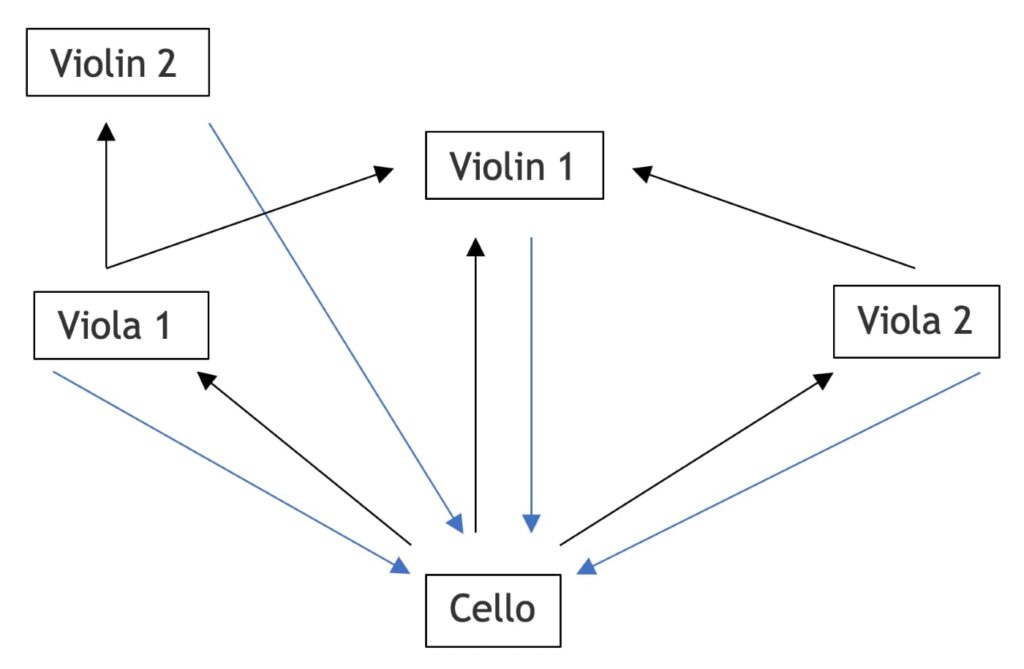Ecosystem
Ecosystem (for String Quintet) was initially inspired by the composer’s exploration and use of evolutionary algorithms to create music (specifically genetic algorithms, with inspiration coming from programs such as Al Biles’ Genjam, and Rodney Waschka II’s Gendash) and the desire to apply evolutionary principles to an acoustic, non-generative context. The composer is also interested in multidisciplinary work combining synthetic biology and the arts. This piece situates itself on the cusp of this space through its use of a cellular automata algorithm (Conway’s Game of Life) for the electronics and engagement with biological principles in the score.
This piece focuses on an ecosystem evolving over time in two alternate realities which shall be described as the ‘main reality’ and the ‘ghost reality’. The music corresponding to the main reality is played by the quintet and represents the ecosystem in its natural form. The ghost reality comes from the granular synthesiser sampling the output of the quintet, manipulating it, and playing it back from different speakers for the duration of the performance. The ghost reality represents the ecosystem being impacted by human progress, with this intervention being initiated by the cellular automata algorithm.
The instruments act as different symbiotic components in the ecosystem which rely on each other. The diagram of this ecosystem is as follows.

Figure 1: The Ecosystem. An arrow pointing from one part to another shows that the former part influences the latter.
The score (the main reality) is inspired by spectral music, with the criterion for fitness in the evolving ecosystem being harmonic purity (pitches, whether vertical or horizontal, being integral multiples of the fundamental pitch, thus representing the harmonic spectrum of a note). The general trend of the evolutionary process is to get closer to this criterion, beginning with more ‘inharmonicity’ (pitches and noises that do not fit into a harmonic spectrum). The interlinked nature of the ecosystem results in fluctuations between harmonicity and inharmonicity in the evolutionary process. This would occur in the natural world through changes in the environment or mutations.
It is important to stress that the references to nature in this piece are metaphorical and do not aim to situate the harmonic series as theoretically ‘natural’ as this view is anthropocentric, as pointed out by Bowling, Purves and O’Callaghan. (1) Harmonic purity has been used as the fitness criterion as it allows the sense of evolution to be perceptible to the listener (who is of course, human), and because it can be manipulated by the Max patch to achieve contrasting effects.
The intention with the electronics (implemented through a Max MSP patch) is to give the listener occasional subtle insights into the ghost reality without it being too intrusive. The parameters of the granular synthesiser are controlled by the cellular automaton Conway’s Game of Life, which is evolutionary. The output of this system is not constant and instead fades in and out from five speakers. The use of the Max patch contributes subtle rhythms, textures and inharmonicity.
Click here to see a pdf of the score
References
(1) James O’Callaghan, ‘Spectral Music and the Appeal to Nature, Twentieth-Century Music, 15.1 (2018), 57-73 (p. 66); Daniel L. Bowling and Dales Purves, ‘A Biological Rationale for Musical Consonance’, Proceedings of the National Academy of Sciences of the United States of America, 112.36 (2015), 11155-11160 (p. 11157).